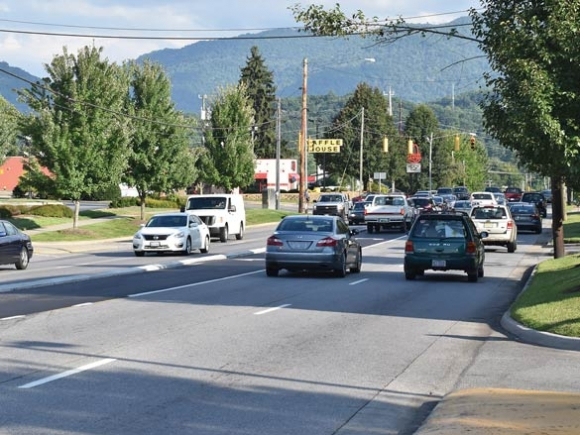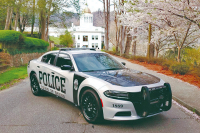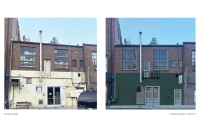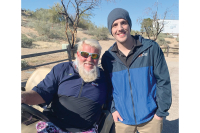Death of the five lane, birth of the boulevard

Waynesville, Sylva and Franklin’s main commercial thoroughfares are getting a makeover, reshaping the fabric of these communities for decades to come.
In all three towns, the five-lane drags clogged with fast-food joints, strip malls, big-box stores and stop lights will tear up their middle suicide lanes for the latest darling in road design: the boulevard concept.
It’s been a long time coming. Just ask Jason Kimenker, who was pushing for the concept long before it was en vogue with mainstream transportation planners.
For more than a decade, Jackson County residents were locked in a bitter battle with the DOT over what to do about congestion on N.C. 107. DOT wanted to build the Southern Loop, a new cross-country highway. But residents rallying under the banner of the Smart Roads Alliance fought for a redesign of 107 instead. Now, they’ve finally won.
“Our children and grandchildren will be enjoying the fruits of the labor we have put in,” Kimenker said.
The happy ending makes it easier to look back at the long haul with a positive spin.
Related Items
“The DOT are members of the community, too,” Kimenker said. “I never felt like we were fighting a bypass as much as creating community engagement.”
Across the Balsams, Elizabeth Teague is watching the same story play out in Waynesville.
“It’s not just here in North Carolina, but across the United States. DOTs across the country are trying to eliminate these five-lane designs to make them safer,” said Teague, Waynesville’s development services director.
For decades, the five-lane drag has been the workhorse of commercial districts. From the five o’clock rush and lunch hour errands to grocery runs and Friday night pizza take-out, the five-lane is the main thoroughfare for heavy trucks, summer tourist throngs and locals just trying to get home.
“They kind of take on a flavor of Main Street, but they weren’t designed as main streets,” Teague said.
Five-lane drags went hand-in-hand with suburban sprawl in decades past. As strip malls and fast food chains engulfed the edges of small town American, a sparkling five-lane became the new front porch of the community.
“They were once on the outskirts of town. But development has grown up all around them,” Teague said.
Setting the stage for commercial growth was in many cases the main purpose of the five lane.
“The folks that supported those five-lanes wanted growth and development to occur and it was done in the name of jobs and it worked. They are loaded, just like folks wanted them to be,” said Joel Setzer, the former head of a 10-county DOT district based in Sylva.
But as they’ve gotten more and more crowded, they aren’t working so well, and are increasingly dangerous.
“It comes to a point that people are getting hurt. We need jobs but we also need to live getting to and from places to shop. So I think the focus has shifted since these five-lanes were built,” said Setzer, who now works as a private transportation consultant.
The five-lane makeovers in Waynesville, Sylva and Franklin are a creative solution to ever-increasing traffic.
“It was essentially a case where the congestion was so great and the number of accidents was so high that the public and local officials recognized that something needed to be done, that the status quo was not acceptable,” said Brian Burch, DOT project development engineer based in Sylva. “The five-lane did work at one time, but with the increase in traffic it gets to a point where it starts to fail.”
Long-time coming
Smart growth planning advocates have decried the sprawl-inducing middle-turn lane as bad road design for two decades. The old-school DOT mantra was that bigger roads equaled better roads, but in the early 2000s transportation reformists in Waynesville and Sylva hosted a visiting Smart Roads expert to teach them about new-fangled design concepts like pulling up middle turn lanes, putting in sidewalks and street trees and making businesses share parking lot entrances.
“He schooled us on modern techniques for traffic calming and he had an arsenal of ideas for managing traffic,” recalled Jeanette Evans, an early voice in the Smart Roads Alliance in Jackson County. “They really made sense.”
But the ideas were considered avant-garde at the time, and weren’t recognized as a viable alternative the DOT, which saw more lanes or new roads as the cure-all. It was unclear whether the community at large would have bought in to the scheme until the past few years.
“I don’t know if the alternatives for access management would have been as well received the level of congestion may not have been to the point where we are today — to where it is unacceptable to local governments and property owners,” Burch said.
Even a few years ago, the idea of replacing middle turn lanes with medians was met with skepticism by business owners. They feared they would be passed over by motorists on the other side of the road if they were sequestered by a median.
But that’s not the case.
“There has been research performed on businesses who claim they are going to suffer as a result of traffic not being able to get to them,” said Mike Reece, a congestion management expert for the DOT’s western region. “What research has shown at the state and national level is that businesses tend to thrive after completion.”
Deep within the DOT, Reese has been helping to lead the paradigm shift away from five-lanes.
“A lot of times the thinking is the only way to solve our congestion problems is to build our way out of it,” Reese said. “Two of the common philosophies I hear is ‘We need more lanes’ and ‘We can build our way out of congestion.’”
Reese has been chipping away at the one-size-fits-all approach since 2000 as part of the DOT congestion management team. And he’s seen the ideas take root and prove their mettle.
Reese recently convinced highway engineers and the public to pull up a lane on a congested stretch of interstate.
“It tends to be counter-intuitive. Normally you think we need more lanes, but it was creating so much turbulence,” Reese said of the one-lane-too-many.
Roundabouts are a classic example of new concepts being embraced. The first roundabout was built by the DOT in the late ‘90s.
“Now we have well over 200 roundabouts in the state,” Reese said.
Incidentally, Waynesville was one the first towns in the state to get a roundabout. It was a hard-fought battle with the DOT to go the roundabout route as part of the Old Asheville Highway widening project 15 years ago, rather than a tried-and-true stop light. But the town won, and the roundabout proved its worth, melting its critics instantly.
To Reese, the same could be said for the super street design today. (See super street article on page 9)
“Trying to have your cake and eat it too can be very challenging,” Reese said. “The super street balances the need to get traffic back and forth and the need to provide access to businesses through the corridor.”
There was another motivator spurring DOT to rethink its toolbox. The recession took a bite out of DOT budgets nationwide.
“So we took a different philosophy and said how can we handle the existing volume of traffic without having to do widening with additional lanes or build a new facility?” Burch said.
Since the mid-1990s, the DOT advocated a new highway dubbed the Southern Loop as the solution to 107 traffic. Too many cars on 107? Build another highway to divert them.
But it would have cost more than $150 million to build a bypass around 107 over virgin countryside. And it was questionable how many would use the bypass, if they had to hit the store on the way home. Critics questioned whether it would do the job.
“The solution is not necessarily to bypass those areas,” Burch said. “You want the same volumes of traffic to get through efficiently and more safely and still have access to those businesses and still have a viable commercial district.”
Trade-off
Despite the appeal of less congestion, it can be a hard sell to convince businesses along five-lanes to forgo a middle turn lane.
“I imagine you are going to get questions from business owners ‘How is this going to impact my business?’” said Rich Price, Jackson County’s economic development director.
Teague agreed that’s a common concern.
“Property owners adjacent to the road say ‘I want people to get to my property from any direction.’ But as the road gets more crowded, the more difficult it actually becomes for someone to get to any particular property,” Teague said.
Reese said the proof’s in the pudding.
“There has been research performed on businesses who claim they are going to suffer as a result of traffic not being able to get to them,” Reese said. “What that research has shown is that businesses tend to thrive after completion.”
Sense of place
Community planners versed in smart growth see another downside to the ubiquitous five-lane. They undermine a sense of place and create an auto-centric society.
The retrofit of five-lane drags in Waynesville, Sylva and Franklin will hopefully create a more walkable community by including sidewalks and pedestrian safe harbors.
“People want to be able to park and walk to multiple destinations,” Teague said. “If someone parks at the bank, but then they want to run over to the Hallmark store, well unfortunately you can’t do that if these streets aren’t designed right, so you get in your car and drive 100 yards. It doesn’t make any sense. The pedestrian space is absolutely critical to the overall function of the corridor.”
The five-lane redesigns being rolled out by the DOT are the result of years of stage setting by local communities like Waynesville, Teague said.
“If people think these ideas and concepts are coming out of the void, the town has been working toward this day for years,” Teague said.
Waynesville commissioned its own corridor study of Russ Avenue in 2010 to lay out a vision for what the corridor should become. The idea was to get ahead of the DOT and make a statement about what the towns wanted, rather than wait and see what the DOT came up with on its own.
“Russ Avenue is a gateway into our community. We want it to be safe. We want it to look nicer. We want it to be bicycle and pedestrian friendly. How do we do that? It has been carefully thought out,” Teague said.
“It worked. They used it as a guiding principal. That planning process is coming to fruition now.”
Sylva got ahead of the DOT train, as well, by commissioning a corridor plan for N.C. 107 in 2011.
“We realized this is our main artery of town and wanted to know what are the options for making it safer and a more desirable place for business and residents,” said Sylva Town Manager Paige Dowling. “It was focused on traffic congestion and safety, but also in beautification with an emphasis, too, on the pedestrian components and other modes of transportation.”
DOT’s own makeover
What’s phenomenal is that DOT listened.
“DOT has come a long way in the past 10 years in terms of being more sensitive to the towns that their roads go through,” Teague said. “It was kind of a sea change.”
Burch admitted the same.
“A lot of times Raleigh vision superseded the local vision,” Burch said. “There is more of a collaborative and cooperative process now.”
Jack Debnam, a former Jackson County commissioner and statewide DOT board member, has been part of that change.
“They listen more to the public now,” Debnam said.
Waynesville saw the leading edge of that change over a decade ago and was astute enough to jump on the bandwagon.
“It put a burden on towns saying ‘Look, if you want us to respond as our road comes through town, then you have to give us something to respond to,’” Teague said. “So Waynesville was one of the first towns that came in with a corridor study.”
Waynesville leaders were pleasantly surprised in 2015 when they got a call from the DOT asking for input before the design team for Russ Avenue put pencil to paper. In the past, DOT floated its own design options first, and the public was pigeonholed into commenting on what was put in front of them.
This time, the DOT wanted to know the town’s preferences before they even got started.
“For the last two years it has become part of what we do in the division. We seek that input before we start, to make sure what we are tasking our consultant with delivering is the vision desired by local governments and the communities,” Burch said.









